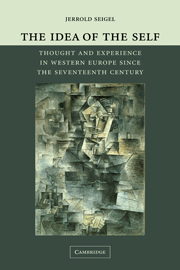Book contents
- Frontmatter
- Contents
- Acknowledgments
- PART I INTRODUCTORY
- 1 Dimensions and contexts of selfhood
- 2 Between ancients and moderns
- PART II BRITISH MODERNITY
- PART III SOCIETY AND SELF-KNOWLEDGE: FRANCE FROM OLD REGIME TO RESTORATION
- PART IV THE WORLD AND THE SELF IN GERMAN IDEALISM
- PART V MODERN VISIONS AND ILLUSIONS
- Notes
- Index
2 - Between ancients and moderns
Published online by Cambridge University Press: 05 June 2012
- Frontmatter
- Contents
- Acknowledgments
- PART I INTRODUCTORY
- 1 Dimensions and contexts of selfhood
- 2 Between ancients and moderns
- PART II BRITISH MODERNITY
- PART III SOCIETY AND SELF-KNOWLEDGE: FRANCE FROM OLD REGIME TO RESTORATION
- PART IV THE WORLD AND THE SELF IN GERMAN IDEALISM
- PART V MODERN VISIONS AND ILLUSIONS
- Notes
- Index
Summary
Saying what is distinctive about modern approaches to the self requires that we compare them with something; ancient and medieval views provide the obvious point of reference. Giving some attention to pre-modern thinking is useful here for two additional reasons. Ancient writers still exercised powerful influence in early modern times, and attending to their views also allows us to consider the claims advanced by historians and philosophers about what was gained or lost in the passage to modern attitudes. We should not suppose that ancient and modern approaches to the self were wholly different, however. Many notions we may think of as characteristically modern were already present in ancient thinking, and this makes the task of specifying the differences more subtle and demanding – but no less important.
In the terms we have been developing here, ancient writers were perfectly aware that human life had corporeal, relational, and reflective dimensions, even if this awareness was only implicit in what they wrote about the self. The bodily dimension of personal existence received strong recognition in the Homeric epics, so much so that a debate has grown up about whether the heroes they depicted had selves at all, in the sense of exercising any active control over their inner urges, or whether they simply responded to the irresistible promptings of passion. Even philosophers who believed firmly in the power of rationality insisted that humans were embodied beings, as we shall note in regard to Aristotle in a moment.
- Type
- Chapter
- Information
- The Idea of the SelfThought and Experience in Western Europe since the Seventeenth Century, pp. 45 - 84Publisher: Cambridge University PressPrint publication year: 2005

